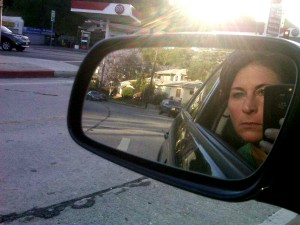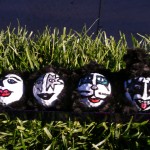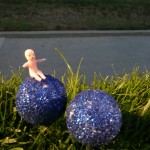Ghettogloss Brings Art Outside the Box – An Interview with Owner Fiora Boes
By Eveline Morel | August 17th, 2012 | Category: L.A. Art & Culture | Comments Off on Ghettogloss Brings Art Outside the Box – An Interview with Owner Fiora Boes“Being an artist, I have a critical and trained eye for looking at art. I understand it from different angles. I get the creative process and can see things as an artist, not just a viewer. I’ve always thought outside the box, and that has also influenced my choices.” —Fiora Boes
Fiora Boes, owner of Ghettogloss, founded the gallery in Silver Lake, in 1999.
Why and how did you start Ghettogloss?
I started Ghettogloss because I needed to have a studio for myself to work out of, but also because I wanted to put quality cutting edge art in movies, TV, and commercials. By cutting edge, I mean street art, graffiti, art that was pushing boundaries. At the time when I started doing this, there wasn’t any contemporary cutting edge art in Movies and television commercials—there was no graffiti, there was no street art represented—everything was art that blended into the walls. Movies, Television Commercials are seen—most people are glued to the television—there’s a lot of exposure that artists can get through this. And Movies, TV, Commercials are a way of getting in front of people, in a different way. You’ll see the art behind the actor without even knowing you’re doing it . . . it was really to do both: I wanted to share what I thought was interesting with the rest of the world, as much as I wanted to do my art.
Does being an artist yourself influence your work with Ghettogloss? If yes, how?
Being an artist, I have a critical and trained eye for looking at art. I understand it from different angles. I get the creative process and can see things as an artist, not just a viewer. I’ve always thought outside the box, and that has also influenced my choices.
 What was your favorite Ghettogloss show?
What was your favorite Ghettogloss show?
My favorite Ghettogloss show was, by far, the last one, the golf balls. I can’t stress enough how important this golf ball show was. There’s no doubt that in my entire career at Ghettogloss, this was the pinnacle of being able to visually speak to everybody in a way that was not threatening, in a way that was outside of a gallery, in a way that people from the layman to the highest art critic could both completely stand back together and have a really amazing dialogue about what is art. In some ways, having all the artists work on the same medium, the golf ball, it synthesized things down to the concept. You got to see the difference in expression, the level of crafting that could go into a piece. And regardless of how simple or how crafted a piece was, you could see the concept behind it. This is the biggest achievement I’ve ever had so far, to convey a message . . . and I almost even didn’t intend to.
What was your least favorite show?
I don’t have one. I have least favorite experiences, but that comes with anything.
” . . . I think that the next movement that comes from street art will be the really important movement. The classically-trained street artists were the ones breaking ground in the beginning, realizing that the street was a place that they could really get exposure for their art without having to pay for billboards, etc., but those were the people that didn’t necessarily have the business background.”—Fiora Boes
Who’s your favorite L.A. artist?
I have a small group of people, but I would rather not attach any names. There’s so much talent in L.A., so much inspiration . . .
 What do you think is Ghettogloss’s greatest contributions to L.A. art & culture?
What do you think is Ghettogloss’s greatest contributions to L.A. art & culture?
I think providing an experience, a non-threatening experience for people, that could lure them into wanting to discover art, whether they came from an art interest background or not.
What do you mean by non-threatening?
Walking into a gallery, for most people, is a threatening, uncomfortable experience. A lot of people that aren’t in the art world don’t understand art; it can be somewhat off-putting for many people. It’s changed now. Art galleries are into parties, but when I started Ghettogloss, that wasn’t the case, it was really hard. I think Ghettogloss is really important in the sense that it provided an experience for the art layman to walk in and by chance, be able to discover art . . . There was always an experience provided. For example, if it was a Dogtown show, there was a skate ramp in the parking lot . . . enough pop culture elements to bring in all walks of life without them realizing they were coming to see art. It’s about the experience. I think the Ghettogloss experience was eye-opening for a lot of people because it made them see things they weren’t normally used to seeing, outside of the gallery, or in other galleries. Ghettogloss lured them in a way that they didn’t realize they were coming into a gallery; they were coming for an experience. And all of a sudden, their eyes would be open, the way someone’s eyes would be open the first time they did acid or did mushrooms . . . all of a sudden. Wow!
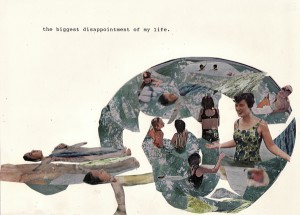 A lot of galleries have now taken the formula of experience now to sell their art. Look at the Art Walk. It’s all a party . . . I think the art scene is a bore. Curators and directors of galleries are so narrow-minded into trying to be something that they’re not that the experience becomes jumbled. They’re catering to their collectors and afraid to step outside the bounds.
A lot of galleries have now taken the formula of experience now to sell their art. Look at the Art Walk. It’s all a party . . . I think the art scene is a bore. Curators and directors of galleries are so narrow-minded into trying to be something that they’re not that the experience becomes jumbled. They’re catering to their collectors and afraid to step outside the bounds.
Have you ever been worried about selling art?
I’ve always been worried about not selling art because I’m not catering to any specific collectors. That was never what I was looking to do in the first place. For me it’s about showing work that touches me, that I really like, or that I think and form, other people can connect to and it can form their minds, and that doesn’t mean a sale. But in time, I find that many of these works become highly valued, whether it’s my sale or not. It may be other people’s sale down the line, but I might have been the first to show these new artists.
So in some ways, you’re a pioneer, discovering new talent . . .
Yes, maybe a pioneer, but not always the one making the most money. You know, pioneers may get the glory but also often end up dead with arrows in their rear ends . . . but the experience is always there, and so is the satisfaction of discovering new talent.
How has art evolved in L.A. over the years?
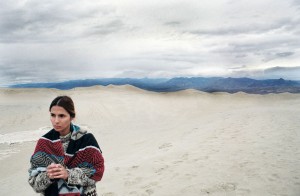 You know I’ve been showing street art for over 13 years, and it’s finally at a place where it’s crossed over into commercial everything: it’s in television commercially, and I’m getting calls all the time for street art in mainstream TV shows. I think what Shepard Fairey has done to the art world changed it a lot. I think that what Mr. Brainwash has done completely turned it upside down and made it cheap, but important, in that people are starting to look at art in ways that they never thought before. But I think that the next movement that comes from street art will be the really important movement. The classically-trained street artists were the ones breaking ground in the beginning, realizing that the street was a place that they could really get exposure for their art without having to pay for billboards, etc., but those were the people that didn’t necessarily have the business background. Now you’re dealing with people that have the business background, that have taken their whole theory and made a ton of money off it.
You know I’ve been showing street art for over 13 years, and it’s finally at a place where it’s crossed over into commercial everything: it’s in television commercially, and I’m getting calls all the time for street art in mainstream TV shows. I think what Shepard Fairey has done to the art world changed it a lot. I think that what Mr. Brainwash has done completely turned it upside down and made it cheap, but important, in that people are starting to look at art in ways that they never thought before. But I think that the next movement that comes from street art will be the really important movement. The classically-trained street artists were the ones breaking ground in the beginning, realizing that the street was a place that they could really get exposure for their art without having to pay for billboards, etc., but those were the people that didn’t necessarily have the business background. Now you’re dealing with people that have the business background, that have taken their whole theory and made a ton of money off it.
Where do you see Ghettogloss heading in the next 5 years? What’s next?
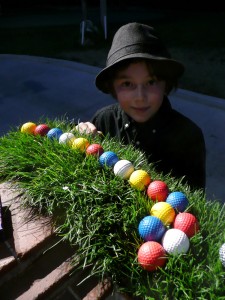 The golf show that I’ve just done, I’m interested in taking this direction, taking the show outside the gallery walls, working with different kinds of spaces that provide an environment beyond what four white walls can provide. They can provide an experience that combines the feeling of a great event along with great visuals, allowing people not to feel like they’re confined in a gallery space, but that they’re somewhere where they’re inspired not only visually, but by a great location.
The golf show that I’ve just done, I’m interested in taking this direction, taking the show outside the gallery walls, working with different kinds of spaces that provide an environment beyond what four white walls can provide. They can provide an experience that combines the feeling of a great event along with great visuals, allowing people not to feel like they’re confined in a gallery space, but that they’re somewhere where they’re inspired not only visually, but by a great location.
I will continue to stay outside the box. Having lived in the woods for the past two years in Vermont, I’ll never be confined to having a gallery space again, unless I have to, for other reasons. I don’t want to be confined into four walls; that’s not where I’d feel happy, where I’d feel inspired.
